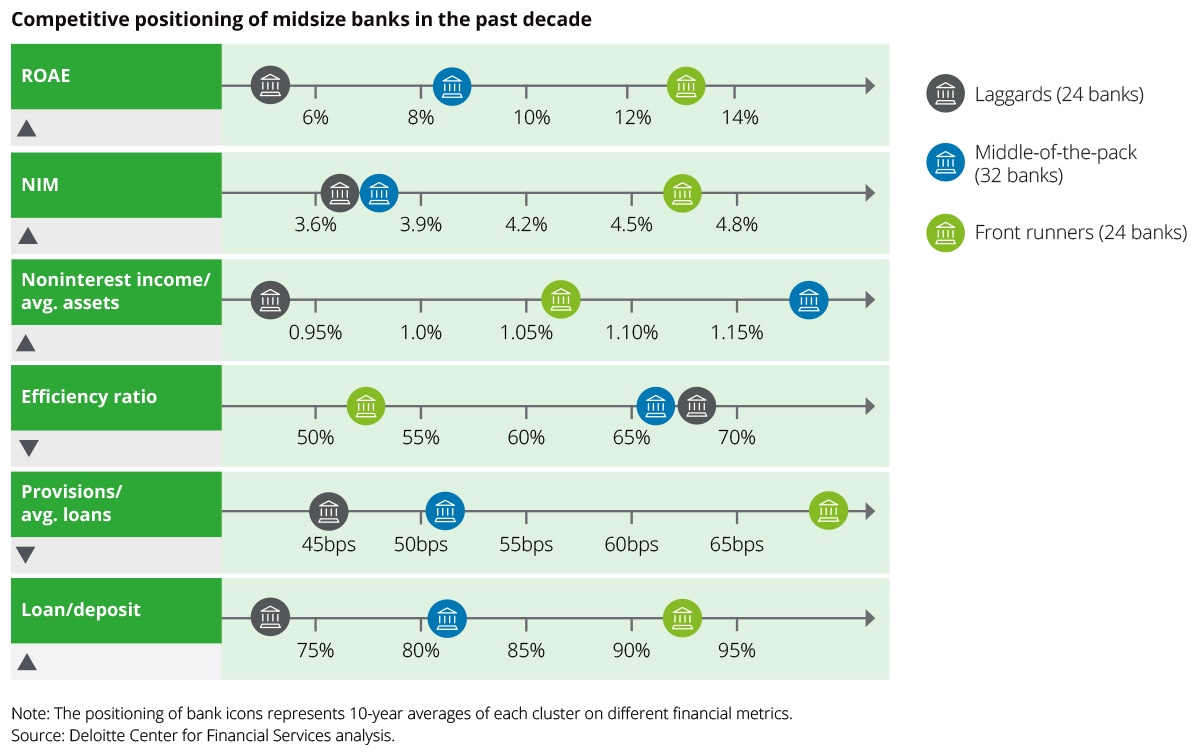Article

The future of midsize banks
A new playbook for supercharging growth
Despite challenges over the past decade, most midsize banks continue to perform well. However, supercharging growth in the postpandemic world will require them to develop a new playbook to address behavioral shifts, macroeconomic challenges, technology limitations, and competitive pressures. Our new report looks at strategies for transformation.
What does the future hold for midsize banks?
The future of midsize banks in the United States appears more tenuous than ever before. Sandwiched between large institutions boasting a national or regional presence and smaller banks touting a community touch, midsize banks’ unique advantages have been pressure-tested in recent years. The recent rise in M&A activity is a testament to the uncertainty facing this banking sector. As the “balance-sheet-first” philosophy gains momentum, what’s the optimal scale to thrive in the future? Is $100 billion in assets the new benchmark in the midsize banking sector?
These questions take on additional significance when considering pandemic-induced shifts. Restrictions on in-person interactions have made most retail customers more comfortable with digital banking services, making visits to bank branches, which have been long-standing relationship-building hubs, few and far in between. At the same time, commercial banking clients have begun to expect a level of ease, accessibility, and sophistication similar to the digital experiences they enjoy in retail banking.
Impending speedbumps for midsize banks to overcome
Furthermore, competitive pressures are intensifying. On the one hand, large banks are expanding in commercial lines of business. On the other hand, nimble fintechs and innovative bigtechs are expanding their reach in financial services. These competitive pressures could put customer retention at risk. Macroeconomic conditions haven’t been favorable, either. Low interest rates are hurting net interest margins (NIM), the biggest drivers of midsize banks’ profitability.
Despite these concerns, during the COVID-19 pandemic, midsize banks rapidly embraced digitization and quickly responded to the demands imposed on them. While midsize banks can learn lessons from historical performance to bolster their competitiveness, it may also be time to reassess their strategic levers for a postpandemic world. However, one size will not fit all, and midsize banks should prioritize the strategic levers that align with their growth agenda.
While the industry has stayed on course, some midsize banks took the lead
Midsize banks tend to excel on a few dimensions compared to their larger peers. For decades, midsize banks championed customer intimacy and a relationship-based business model with a laser-sharp focus on the lending business. This has enabled them to consistently earn higher net interest margins compared with larger banks in the past decade. However, their business model is typically less diversified, and they’ve gradually reduced reliance on fee-based revenues as a share of average assets over the past decade.
Looking deeper, analysis shows that not all midsize banks have been equally profitable. Some have been adept at maintaining superior financial performance on a consistent basis, while others have repeatedly lagged. Our analysis identified meaningful differences in their performance drivers, competitive positioning, and unique challenges (figure 1).
- Frontrunners consistently maintained 14%+ RoE on average in the last decade, including a ~12% RoE in a turbulent 2020.
- The middle-of-the-pack demonstrated a consistent performance, generating 8% RoE in most of the years in the past decade. After picking momentum in 2018 and 2019, their RoE returned to 8% in 2020.
- Laggards generated 6% RoE on average in most of the years in the past decade, reaching 9% in 2018 and 8% in 2019. However, this group of banks generated a negative 2% RoE on average in the past year.

The post–COVID-19 journey could be bumpy, requiring bolder choices
It is clear that COVID-19 has accelerated the digitization of the global economy and has brought about structural shifts in the banking space. Midsize banks should avoid any sense of complacency and not simply rely on their past performance to chart growth and competitiveness in the future. Midsize banks should consider these strategies as they plan for a post–COVID-19 world:
Gearing up to competitively position in a postpandemic world
Midsize banks have played a vital role of financial intermediation in the US economy and have supported millions of consumers’ and businesses’ financial needs and dreams for decades.
But historical performance alone can no longer determine their future success. Uncertainty and impending challenges in the short term shouldn’t discourage them from making the bold, uncomfortable choices often required to position themselves competitively in the long run and find their niche to thrive. Trying to be a bank for all customers and all needs will likely not be the road to success in the future of banking. Midsize banks should pick their areas of competitive differentiation and invest in growth and scale to ensure a prosperous future.
Given the differences in their business models, these strategic choices will likely vary by institution. Those that adopt a new strategic playbook based on their distinct positioning could stand a brighter chance of supercharging their growth in a postpandemic world.

